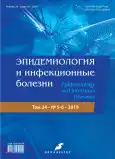Anthrax in Dagestan: clinical and epidemiological characteristics, risks, and prognosis of a group outbreak in 2019
- Authors: Shakhmardanov M.Z.1, Abusuevа A.S.2, Nikiforov V.V.1, Tomilin Y.N.1, Burova S.V.1
-
Affiliations:
- Pirogov Russian National Research Medical University
- Dagestan State Medical University
- Issue: Vol 24, No 5-6 (2019)
- Pages: 213-219
- Section: Original study articles
- URL: https://journals.rcsi.science/1560-9529/article/view/34791
- DOI: https://doi.org/10.17816/EID34791
- ID: 34791
Cite item
Full Text
Abstract
Anthrax continues to pose a serious problem for the healthcare and agricultural industries of Russia. Since 1900, over 70,000 outbreaks of human and animal infection have been recorded in Russia. Despite ongoing anti-epidemic measures, epizootics and epidemic foci of anthrax are recorded annually. Over the past 10 years, 23 anthrax outbreaks among people have been recorded in the Russian Federation with a morbidity rate of 90 people, and three fatal outcomes were observed. The Caucasus region ranks first in the Russian Federation in the incidence of anthrax in people and animals. The Republic of Dagestan is a region that is highly prone to anthrax. The spread is aggravated by landscape and environmental conditions that are favorable to the formation and long-term existence of anthrax foci. In most cases, the disease arises in areas previously considered safe for this infection, which indicates the presence of unregistered animal burial sites and the lack of proper control over sanitary condition. People become infected with anthrax due to the uncontrolled and forced farm slaughter of sick animals resulting from the lack of facilities for sanitary slaughter. Human infection occurs mainly during the slaughter of sick cattle, carving, and contact with animal raw materials. This article illustrates a group of anthrax outbreaks that occurred as a result of contact with a sick animal during slaughter and carving. Four local residents of one village fell ill, and in all of them, anthrax manifested in the form of a moderate skin course. The last case of anthrax in cattle in the said locality was recorded in 1958. This fact highlights the importance of compliance with anti-epidemic measures, including the so-called settlements that are safe for anthrax.
Full Text
##article.viewOnOriginalSite##About the authors
Murad Z. Shakhmardanov
Pirogov Russian National Research Medical University
Author for correspondence.
Email: mur2025@rambler.ru
ORCID iD: 0000-0002-3168-2169
MD, PhD, Professor
Russian Federation, MoscowAida S. Abusuevа
Dagestan State Medical University
Email: amur39@mail.ru
ORCID iD: 0000-0002-6999-1696
MD, PhD
Russian Federation, MakhachkalaVladimir V. Nikiforov
Pirogov Russian National Research Medical University
Email: v.v.nikiforov@gmail.com
MD, PhD, Professor
Russian Federation, MoscowYuri N. Tomilin
Pirogov Russian National Research Medical University
Email: papa220471@mail.ru
ORCID iD: 0000-0003-2767-4868
MD, PhD
Russian Federation, MoscowSvetlana V. Burova
Pirogov Russian National Research Medical University
Email: svburova@list.ru
ORCID iD: 0000-0001-7664-7685
MD, PhD
Russian Federation, MoscowReferences
- Попова А.Ю., Ежлова Е.Б., Демина Ю.В., и др. Пути совершенствования эпидемиологического надзора и контроля за сибирской язвой в Российской Федерации // Проблемы особо опасных инфекций. — 2017. — №1. — С. 84–88. [Popova AYu, Ezhlova EB, Demina YuV, et al. Ways to improve the epidemiological surveillance and control of anthrax in the Russian Federation. Problems of particularly dangerous infections. 2017;(1):84–88. (In Russ).] doi: https://doi.org/10.21055/0370-1069-2017-1-84-88
- Рязанова А.Г., Ежлова Е.Б., Пакскина Н.Д., и др. Ситуация по сибирской язве в 2018 г., прогноз на 2019 г. // Проблемы особо опасных инфекций. — 2019. — №1. — С. 98–102. [Ryazanova AG, Ezhlova EB, Pakskina ND, et al. Epidemiological situation on anthrax in 2018, the forecast for 2019. Problems of particularly dangerous infections. 2019;(1):98–102. (In Russ).] doi: https://doi.org/10.21055/0370-1069-2019-1-98-102
- Куличенко А.Н., Буравцева Н.П., Антюганов С.Н., и др. Сибирская язва в Дагестане // Проблемы особо опасных инфекций. — 2013. — №2. — С. 22–25. [Kulichenko AN, Buravtseva NP, Antyuganov SN, et al. Anthrax in the territory of Dagestan. Problems of particularly dangerous infections. 2013;(2):22–25. (In Russ).]
- Логвин Ф.В., Кондратенко Т.А., Водяницкая С.Ю. Сибирская язва в мире, странах СНГ и Российской Федерации (обзор литературы) // Медицинский вестник Юга России. — 2017. — Т.8. — №3. — С. 17–22. [Logvin FV, Kondratenko TA, Vodyanitskya SYu. Anthrax in the world, cis and Russian Federation (literature review). Medicinskii vestnik Juga Rossii. 2017;8(3):17–22. (In Russ).] doi: https://doi.org/10.21886/2219-8075-2017-8-3-17-22
- Зульпукарова Н.М., Мамаев И.А., Магомедалиева С.Г., и др. Эпидемические и клинические особенности некоторых природноочаговых инфекционных заболеваний в республике Дагестан // Вестник новых медицинских технологий. Электронное издание. — 2018. — №4. — С. 77–82. [Zulpukarova NM, Mamaev IA, Magomedalieva SG, et al. Epidemic and clinical features of some natural focal infectious diseases in the republic of Dagestan. Journal of new medical technologies. 2018;(4):77–82. (In Russ).] doi: https://doi.org/10.24411/2075-4094-2018-16095
- Гаврилов В.А., Грязнева Т.Н., Селиверстов В.В. Почвенные очаги сибирской язвы: реалии и проблемы // Ветеринария, зоотехния и биотехнология. — 2017. — №8. — С. 17–22. [Gavrilov VA, Gryasneva TN, Seliverstov VV. Soil hearth anthrax: realities and challenges. Veterinariia, zootehniia i biotehnologiia. 2017;(8):17–22. (In Russ).]
- Симонова Е.Г., Раичич С.Р., Картавая С.А., и др. Проявления активности стационарно неблагополучных по сибирской язве пунктов Российской Федерации в современных условиях // Проблемы особо опасных инфекций. — 2018. — №2. — С. 90–94. [Simonova EG, Raichich SR, Kartavaya SA, et al. Manifestation of activity of potentially hazardous as regards anthrax areas across the Russian Federation under current conditions. Problems of particularly dangerous infections. 2018;(2):90–94. (In Russ).] doi: https://doi.org/10.21055/0370-1069-2018-2-90-94
Supplementary files











